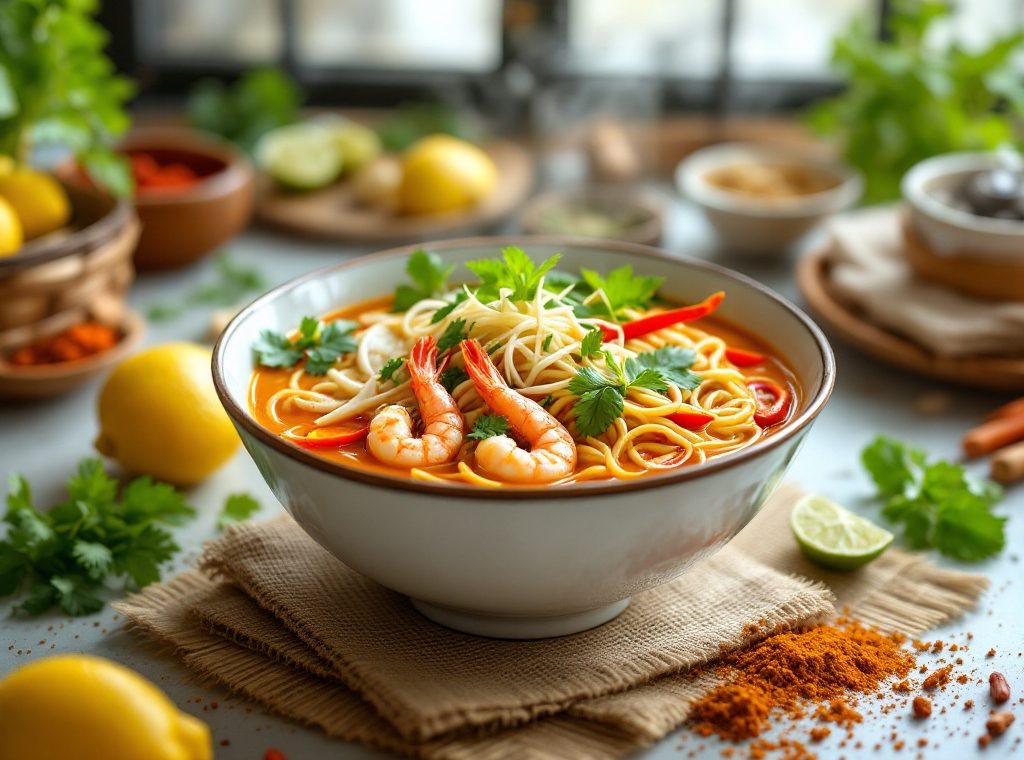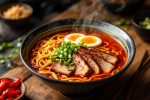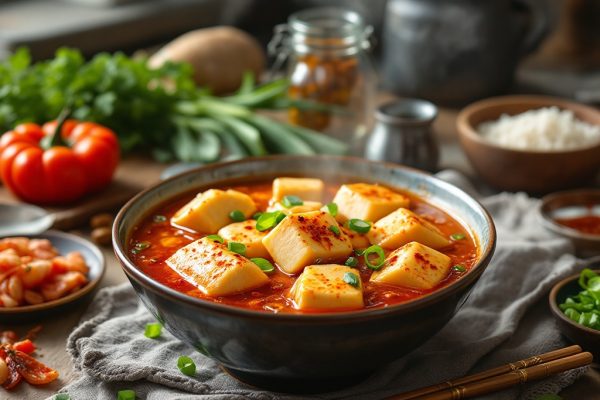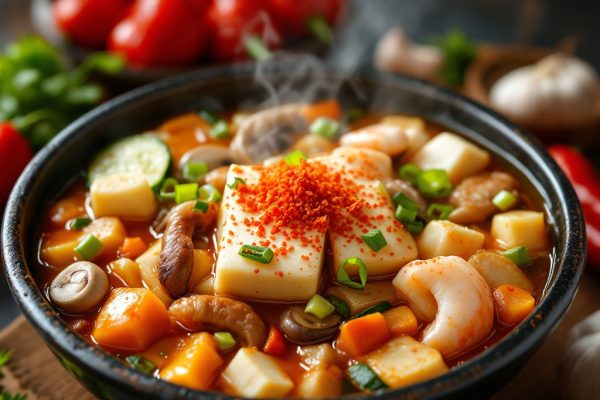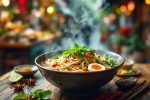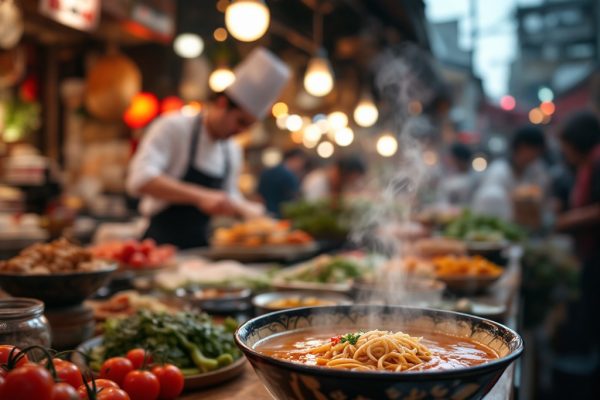Malaysian Laksa Noodles: Have the Taste of Southern Asia
Embark on a culinary adventure through Southeast Asia with Laksa, a flavorful spicy noodle soup steeped in Peranakan tradition. From the creamy coconut curry of Curry Laksa to the tangy fish broth of Asam Laksa, discover the diverse regional variations of this iconic dish. Learn about the key ingredients, spices, and toppings that create Laksa’s distinctive character, a harmonious blend of Chinese and Malay culinary influences. Explore the rich history and cultural significance of Laksa, and unlock the secrets to making authentic, restaurant-quality Laksa in your own kitchen. Dive in and savor the rich tapestry of flavors!
Important information
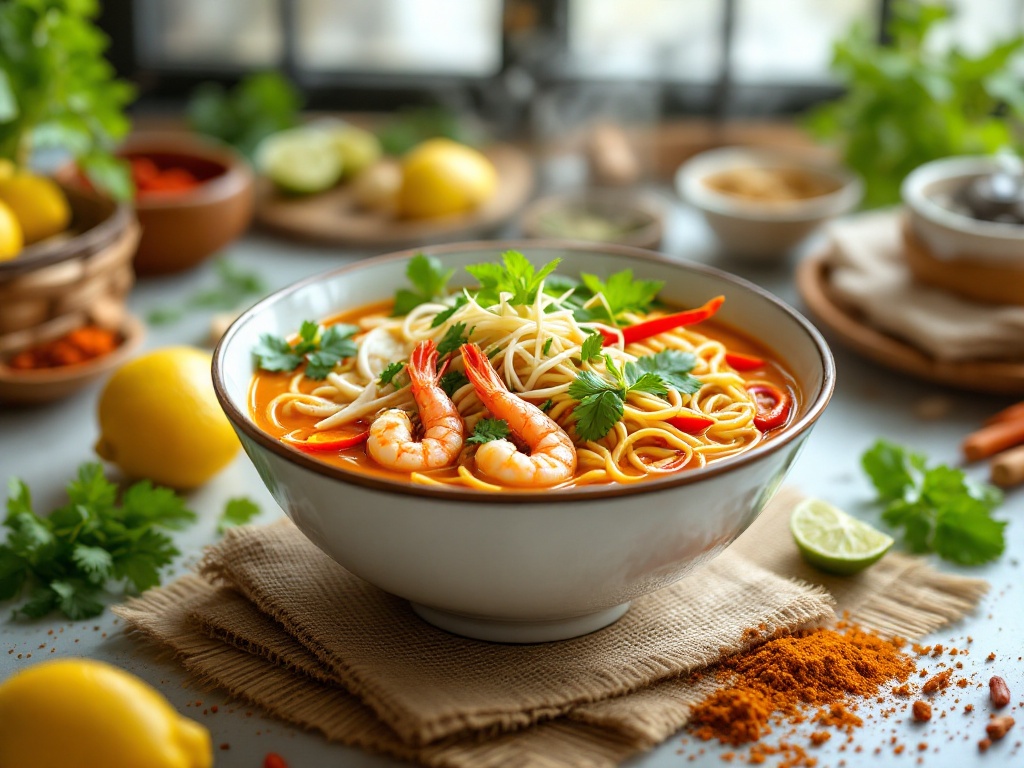
- Laksa is a spicy noodle soup from Southeast Asia, especially popular in Malaysia and Singapore, featuring a rich coconut curry broth.
- It’s a fusion dish, blending Chinese and Malay culinary traditions, reflected in the noodles and the use of coconut milk and spices.
- Key ingredients include coconut milk, chili paste or fresh chilies, lemongrass, galangal, turmeric, and often shrimp paste or fish sauce.
- There are many regional variations, like Asam Laksa (sour and fishy), Curry Laksa (rich and creamy), and Johor Laksa (with spaghetti noodles).
- Laksa paste is the base of the dish; choose one based on spice level and the type of Laksa you want to make.
What is Laksa?
Laksa is a flavorful and satisfying spicy noodle soup, popular in Southeast Asia, particularly Malaysia and Singapore. This dish features thick noodles, often rice or egg, served in a rich, spicy coconut curry broth.
Origin and Popularity in Southern Asia
Laksa, a cherished dish throughout Southeast Asia, particularly in Malaysia, Singapore, and Indonesia, originates from the unique blend of Chinese and Malay cultures that formed the Peranakan tradition. Its diverse and adaptable flavors cater to a wide range of regional tastes, contributing to its widespread appeal.
Key Characteristics of Laksa
Laksa’s rich, spicy broth, often made with a coconut milk base and chili paste or fresh chilies, delivers a delicious blend of heat, creaminess, and fragrant spices. Common garnishes include bean sprouts, fresh herbs like cilantro and mint, and a squeeze of lime. It’s typically served hot.
The Cultural Significance of Laksa in Southeast Asia
Laksa, a beloved Southeast Asian dish, is deeply ingrained in Peranakan culture, a unique blend of Chinese and Malay influences. This vibrant heritage is reflected in Laksa’s rich flavors and history, making it a staple at both celebrations and everyday meals. Over time, Laksa has evolved while continuing to represent cultural harmony, connecting generations through a shared culinary experience.
A signature dish of Peranakan cuisine, Laksa expertly fuses Chinese and Malay spices, ingredients, and cooking techniques. This harmonious blend of flavors exemplifies the region’s unique culinary heritage.
Laksa’s distinct character arises from the fusion of Chinese and Malay culinary traditions. Chinese influences are evident in the noodles, while the coconut milk and Southeast Asian spices contribute distinct Malay flavors. This combination creates Laksa’s complex and delicious taste, making it a truly special dish.
Role in Peranakan Cuisine
Laksa, a cornerstone of Peranakan cuisine, artfully blends Chinese and Malay culinary traditions. This spicy noodle soup exemplifies the fusion of local ingredients and distinct cooking techniques, making it a true culinary masterpiece.
Influence of Chinese and Malay Culinary Heritage
Laksa, a flavorful fusion dish, harmoniously blends Chinese and Malay culinary traditions. The Chinese influence is evident in the noodles and soy-based components, while the coconut milk, lemongrass, galangal, and chilies infuse the dish with distinct Malay flavors. This unique combination is a cornerstone of Peranakan cuisine, where laksa enjoys immense popularity.
Ingredients of Malaysian Laksa Noodles
Laksa variations are distinguished by their noodles: thick rice noodles star in Sarawak Laksa, while thinner rice vermicelli is common in Curry Laksa. Asam Laksa features yellow wheat noodles. Each boasts a rich, spicy, coconut milk-based broth, infused with warming spices like lemongrass, galangal, and chilies. Shrimp paste or fish sauce contribute savory depth, with tamarind providing Asam Laksa’s signature tang. Key spices like turmeric, cumin, and coriander build the flavor foundation. Toppings enhance the experience, often including bean sprouts, fresh herbs (mint and cilantro), and lime wedges. Hard-boiled eggs, tofu puffs, and fried shallots add further texture and taste, while seafood like prawns and fish often complete the dish.
Sarawak Laksa
Thick rice noodles, rich, spicy, coconut milk-based broth.
Curry Laksa
Thin rice vermicelli, rich, spicy, coconut milk-based broth.
Asam Laksa
Yellow wheat noodles, rich, spicy, coconut milk-based broth with a signature tang from tamarind.
Common broth spices: lemongrass, galangal, chilies, turmeric, cumin, coriander, shrimp paste or fish sauce.
Common toppings: bean sprouts, fresh herbs (mint and cilantro), lime wedges, hard-boiled eggs, tofu puffs, fried shallots, prawns, and fish.
Types of Noodles Used
Laksa often combines thick rice noodles and chewy egg noodles for a delightful textural contrast. The rice noodles offer a soft, slippery feel, while the egg noodles provide a satisfying bite.
The Rich and Spicy Coconut Milk Broth
Malaysian Laksa starts with a rich and spicy coconut milk broth, offering a subtly sweet and creamy flavor. Aromatic spices, such as chili, lemongrass, and turmeric, simmer in the coconut milk, creating a flavorful foundation for the dish. Noodles are then added to this delicious base.
Essential Spices and Toppings
Southeast Asian cuisine derives its distinctive flavors from a blend of spices, fresh herbs, and flavorful additions. The foundation lies in spices like chilies, lemongrass, galangal, turmeric, and shrimp paste, creating a rich and savory base for many dishes. Fresh herbs, including mint and cilantro, along with bean sprouts and lime wedges, provide a refreshing lift as common toppings. For those seeking an extra layer of flavor, fried shallots and sambal (chili paste) deliver a punch of heat and complexity. Finally, the inclusion of blanched greens and cool cucumber slices offers a refreshing contrast to the richness, achieving a balanced and delicious culinary experience.
Exploring the Complex Flavors of Laksa
Laksa’s delicious flavor comes from a balanced blend of tastes and textures. Creamy coconut milk tempers the chili heat, while fragrant herbs like lemongrass, galangal, and ginger add depth. This symphony of sweet, sour, salty, and spicy notes creates a harmonious and satisfying dish. The coconut milk cools the spice and provides a rich foundation for the flavors to meld beautifully.
Balancing Heat, Creaminess, and Aromatics
Laksa is a flavorful dish built on contrasts. The heat of chili peppers is balanced by the creamy richness of coconut milk, creating a harmonious blend of fire and comfort. Aromatic spices like lemongrass, galangal, and turmeric further enhance the complexity, making laksa a true sensory delight.
The Role of Coconut Milk in Flavor Profile
Coconut milk lends laksa its signature creamy texture and a touch of sweetness, creating the dish’s rich and distinctive flavor.
Regional Variations of Laksa
Asam Laksa
Asam Laksa excites the palate with its sour and spicy fish broth, derived from tamarind. Mackerel is often used in this dish.
Curry Laksa
Curry Laksa offers a rich, creamy coconut milk broth. It often includes shrimp, chicken, or tofu.
Nyonya Laksa
Originating in Malacca and Singapore, Nyonya Laksa, also known as Peranakan Laksa, blends the flavors of Asam and Curry Laksa. This creates a sweet, sour, and spicy experience.
Johor Laksa
Unique to Johor, Malaysia, Johor Laksa uses spaghetti noodles instead of traditional rice noodles. Its broth is thicker and richer, often infused with dried fish and spices.
Asam Laksa
Asam Laksa is a tangy, fish-based soup made with mackerel and tamarind, resulting in a distinctive flavor profile quite unlike Curry Laksa.
Curry Laksa
Curry Laksa is a flavorful noodle soup renowned for its rich, spicy coconut milk broth. This creamy base perfectly balances the curry’s heat, creating a truly aromatic dish. It’s often served with chicken, shrimp, or tofu and further enhanced by toppings like crunchy bean sprouts and fresh herbs. A final squeeze of lime brightens the flavors, resulting in a delicious and complex culinary experience.
Nyonya Laksa
Nyonya laksa, a hallmark of Peranakan cuisine, is a delicious dish blending Malay and Chinese traditions. Its rich broth, infused with a unique spice blend, creates a truly special flavor.
Johor Laksa
Johor Laksa, a unique Malaysian delight, features thick, spicy gravy coating spaghetti-like noodles. This unusual noodle choice distinguishes it from other laksas, which typically use vermicelli or flat rice noodles. The rich, flavorful gravy further enhances Johor Laksa’s distinctive character, making it a must-try for any laksa enthusiast.
Making Malaysian Laksa at Home
Recreate the vibrant flavors of Malaysian Laksa in your own kitchen. The secret lies in the foundation: a quality laksa paste. This paste builds the dish’s distinctive character. To develop the rich broth, simmer coconut milk with the paste and aromatic spices like lemongrass, galangal, and turmeric. Cook noodles separately and then add them to the fragrant broth. Shrimp, chicken, or tofu provide satisfying protein. Finally, elevate the dish with fresh cilantro, mint, and a squeeze of lime. Consider adding fried tofu puffs or fish cakes for extra flair. Explore the diverse world of laksa, from the creamy coconut curry of Curry Laksa to the tangy fish broth of Asam Laksa—each a unique culinary experience.
Step-by-Step Cooking Instructions
Begin by creating the flavorful laksa broth. In a pot, combine the laksa paste, coconut milk, and water (or stock). Simmer for 10-15 minutes to meld the flavors.
Cook the noodles as directed on the package. Then, rinse them under cold water to prevent sticking.
To assemble your laksa, place the noodles in a bowl and ladle the hot broth over them.
Add your favorite toppings. Popular options include shrimp, chicken, tofu puffs, crunchy bean sprouts, and fresh herbs like mint and coriander for a burst of flavor.
Choosing the Right Laksa Paste
Laksa pastes simplify cooking, but consider your desired spice level and the type of laksa you’re making. Asam Laksa and Curry Laksa, for instance, offer distinct flavors. Some pastes incorporate dried shrimp for a unique taste, so check the ingredients for preservatives and additives. Fresh pastes, often found in local markets, can provide a more authentic experience. When choosing a laksa paste, consider these factors:
- Spice level: Laksa pastes range from mild to very spicy, so choose one that suits your preference.
- Laksa type: Different laksa variations require specific pastes; ensure the paste matches the recipe you’re using.
- Ingredients: Check for dried shrimp (if desired), preservatives, and additives, opting for fresh pastes when possible.
Tips for Restaurant Quality Laksa
Start with a high-quality laksa paste, fresh ingredients are essential for the best flavor.
Balance the rich coconut milk with a squeeze of lime juice.
Gently simmer the broth to meld the flavors.
Cook the noodles al dente, be careful not to overcook them.
Garnish with fresh herbs such as mint, cilantro, or Thai basil.
Add a dollop of sambal oelek for spice and crispy fried shallots for crunch.

